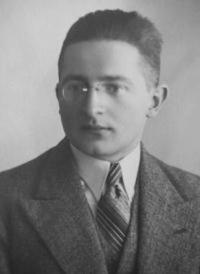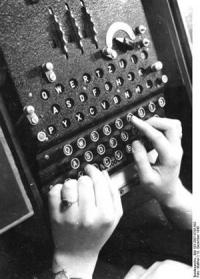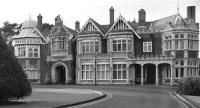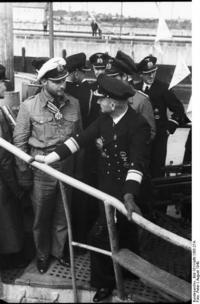Written By: Sam Ghaleb; Ridgecrest, Calif.

Polish cryptanalyst Marian Rejewski

The 3 rotor Enigma

Enigma rotor stack

Bletchley Park, British nerve centre for code breaking and cryptography.

Julius Lemp, Cdr. of the U-110 (left & Grand Admiral Karl Doenitz

Arthur Scherbius, German electrical engineer
After the end of World War I, it became clear to the German military leaders that during the war the British were intercepting and deciphering their secret messages. The British also published reports after the war of how these deciphered messages enabled them to fight the war in a better way. These facts made it clear to the Germans that a need for a better ciphering system was crucial for the German military. With this in mind they began to look for a new system that would ensure the secrecy of their communications. They found the answer in a machine that was originally presented to them in 1918.
The new ciphering machine was called “Enigma.” It was invented by a German electrical engineer named Arthur Scherbius. The Enigma machine was an entirely different ciphering machine. It used an electro-mechanical system to change plain text messages into code. The greatest selling point of this machine was that even if the machine fell into enemy hands, it would still be useless. The secret of the machine lay in its rotors. These rotors were actually like gears; every time a keystroke was made, a rotor would turn 1/26 of a rotation. The machines that were used at the beginning of World War II employed three rotors. Once the first rotor rotated twenty-six times, the second rotor moved one position. The strength of this coding system lies in these variable elements. These elements can be set in many billions of combinations, and each one will generate a completely different cipher-text message. If you know how the machine has been set up, you can type the cipher-text back in and it will unscramble the message. If you don't know the Enigma setting, the message remains indecipherable.
The German Military placed a lot of confidence in the security of the Enigma machine because they thought that the probability of breaking a message would be almost zero for their enemies. The Germans did have certain procedures on the operation of the machine. They also had manuals that the operator used to set the parameters of the machine for each day.
The German Navy started buying Enigma machines in 1925 and they started to modify it. The German Army soon followed suit and they also modified the machine. Some of the modifications included adding or deleting some keys, the addition of the plug board, and using more than three rotors.
The British, French, and Polish attempts to decipher German codes began long before World War II - at about the same time that Hitler began his rise to power. Poland had become extremely proficient at reading the encrypted messages of both the Soviets and the Germans. Since the recreation of their country in 1918, the Poles felt threatened by both the Germans and the Soviets. One of the major ways in which they protected their country was by knowing exactly what either enemy was doing. In 1926, intelligence experts in Poland began to notice a change in German naval crypto-messages. Then, in 1928, the Polish intelligence service noticed a similar change in the crypto-messages of the German army. The Poles began to suspect a new ciphering machine. This notion was confirmed by spies, or by listening to German radio traffic. Once the Poles became aware of the fact that it was an Enigma machine that was doing the encryption, they bought and tested a commercial model of the device. It was soon realized that the commercial version was very different from the military version.
The first step, which started the effort to break the German Enigma machine codes, was the result of treason on the German side. Hans Schmidt, because of a complicated personal life, contacted the French intelligence in 1931 and offered to sell them top secret documents for money. Schmidt gave the French intelligence not just the Enigma machine's operating manual, but also settings lists. The French and British code breakers at those early pre-war years could not decipher the Enigma even with this intelligence treasure, so they shared it with the Polish code breakers. The Polish code breakers realized that even with the available documentation of the German Enigma machine, the only way to ever decipher Enigma messages is to build an Enigma-like machine, which would help them decipher it, and unlike the British and French code breakers, they did so in 1932.
As the Poles were attempting to use math to crack the Enigma, the French felt that the Enigma could only be beat with the aid of keys obtained from Germany. The French managed to buy from a German officer various information about the machine. However, what the French purchased did not give them enough information to decipher German crypto-messages, so they took their intelligence to the British and the Poles. The British were not able to make anything new of the information. The Poles, on the other hand, with their already extensive understanding of the Enigma machine, were able to learn a great deal more. The intelligence information that was bought from the German explained the importance of the positioning of the wheels and the workings of the rotors. The documents also described the plug board, which was not present on the commercial version of the machine that the Poles had bought. Even with all of this knowledge about the machine, the Poles informed the French that without a key to the correct position of the rotors any decryption would be impossible. The French then went back to their contact and purchased the keys to the Enigma machine. These documents were sent to the Poles who used them to work on recreating the wiring of the rotors. After three months of work, Marian Rejewski, Poland’s leading mathematical cryptanalyst, was able to recreate the wiring to rotor one, and soon after that the wiring to the rest of the rotors. In doing this he accomplished what the Germans thought was impossible. While the Poles recreated a military version of the Enigma machine, they were still unable to read the German messages on a regular basis. That was the beauty of the Enigma machine.
With their Enigma-like machine built, and later with a more advanced version they nicknamed "Bombe", the Polish code breakers successfully deciphered German Enigma messages for over six years until 1938, and they did not tell the French anything about it.
As part of the German military preparations for war, the Germans made several improvements to the Enigma machine which made it much harder to break the code. The Polish code breakers struggled with the new challenges by themselves for over a year, with some success, but eventually they decided to share all they knew with the French and British code breakers. They did so just one month before Hitler's invasion of Poland. It was much too late to save Poland from Adolf Hitler, but the Enigma machine code breaking knowledge provided by the Polish code breakers was extremely important.
Prior to the start of World War II, Poland called British and French officials to Warsaw. There they were given a tour of the Polish code breaking facilities and then, most importantly, they were shown the replica Enigma machine, and the machine that the Poles had created to help them determine the key for certain messages. They were then given Enigma replicas and documents on all of the Polish findings. The British and French gladly accepted these gifts and immediately set out to create a system for finding the key for each message. When Hitler invaded Poland, the Polish code-breakers destroyed all of their documents and machines and escaped to France. There they began working in the French intelligence service.
It is estimated, that, without the Polish knowledge, learned in over six years of code breaking, the British code breakers could not have efficiently deciphered the Enigma Machine before 1942.
During the war the British code breakers received an intelligence bonanza when the Royal Navy captured naval Enigma rotors from the submarine U-33 which was captured and boarded by a boarding party from the minesweeper H.M.S Gleaner. For the Royal Navy, it was especially important to obtain German naval ciphers because the German navy, by the start of the war, equipped their Enigmas with five rotors instead of three, making their messages much harder to decipher than those of the Luftwaffe or the Army. It was also crucial because Britain was being strangled to death by the unrestricted German submarine warfare.
In May of 1941, another British intelligence success was accomplished when U-110 under the command of Julius Lemp, was captured by H.M.S. Bulldog. An Enigma machine was retrieved from the U-boat; however, this was not the most important item found on board. The British already had several Enigma machines, but the codebooks were also found and proved to be invaluable. These codebooks allowed for “major insight” into German naval operations. British intelligence realized that if word of U-110's capture got out, the Germans would change all their Enigma machines by updating their cryptography to ensure their communications remained secret. The order went out to the Royal Navy to scuttle the U-boat rather than bring it back to port, and so U-110 was sunk in the Atlantic. The captured documents from the German U-boat enabled the British intelligence service to decipher a German naval message in around six hours. This was a phenomenal ability for the British.
The U.S. Navy also had a hand in the race to crack the German messages. The navy had intelligence services that were set up to try and decipher intercepted radio traffic. The U.S. Navy also captured a German U-boat, U-505, in 1944. There were several other U-boats captured throughout the war, with each one providing its own little piece to the puzzle.
Captured Enigma machines and code books were taken by the British to Bletchley Park. Code-named ULTRA, Bletchley Park was the nerve centre for code breaking and cryptography in Britain during the war. Alan Turing, father of the digital computer, worked with a team of cryptographers and code breakers, and eventually broke the Enigma's cipher.
These amazing real war events were the material which inspired book and movie authors. Ian Fleming, who later became the author of the famous 007 James Bond novels, was himself involved in planning Enigma capture operations. In 2000, Hollywood released “U-571,” a fiction film which depicted the capture of the Enigma from U-110 by the U.S. Navy. However, it was British personnel from the destroyer HMS Bulldog who first captured a naval Enigma machine from U-110 in the North Atlantic in May 1941, before the United States entered the war. Some Enigma-related operations remained under a deep cover of secrecy for decades after World War II.
«Go back to the previous page.





